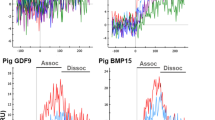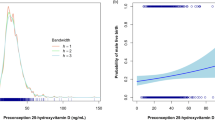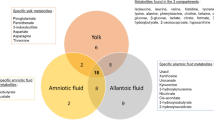Abstract
THREE different types of haemoglobin appear at various stages of development of the human embryo and foetus. The existence of an embryonic haemoglobin1 was long in question until Huehns2 and Kleihauer3 confirmed that it occurs in normal human embryos of crown-rump length less than 8.5 cm. The quantitative relations and chemical properties of the embryonic haemoglobins Gower 1 and Gower 2 were thoroughly studied by Huehns et al.2. As the foetus develops, adult haemoglobin is produced in increasing amounts, and 6 months after birth it has almost completely replaced the foetal haemoglobin. The relation between the increased adult haemoglobin production and the increasing bone marrow activity during foetal stages is purely chronological. Foetal and adult haemoglobin can be synthesized in the liver as well as in bone marrow4,5.
This is a preview of subscription content, access via your institution
Access options
Subscribe to this journal
Receive 51 print issues and online access
$199.00 per year
only $3.90 per issue
Buy this article
- Purchase on Springer Link
- Instant access to full article PDF
Prices may be subject to local taxes which are calculated during checkout
Similar content being viewed by others
References
Drescher, H., and Künzer, W., Klin. Wschr., 32, 92 (1954).
Huehns, E. R., Beaven, G. H., Keil, J. V., Hecht, F., and Motulsky, A. G., Nature, 201, 1059 (1964).
Kleihauer, E., Betke, K., and König, P. A., Klin. Wschr., 43, 435 (1965).
Betke, K., and Kleihauer, E., Blut, 4, 241 (1958).
Thomas, E. D., Lochte, H. L., Greenough, W. B., and Wales, M., Nature, 185, 396 (1960).
Gratzer, W. B., and Allison, A. C., Biol. Rev., 35, 458 (1960).
Muller, C. J., Molecular Evolution (Van Gorcum-Assen, 1961).
Manwell, C., Baker, C. M. A., Roslansky, J. D., and Foght, M., Proc. U.S. Nat. Acad. Sci., 49, 496 (1963).
Kurata, Y., and Arakawa, W., Blut, 9, 42 (1963).
Kleihauer, E., and Brauchle, E., paper read at Tenth Cong. Europ. Soc. Haematol., Strasbourg (1965).
Author information
Authors and Affiliations
Rights and permissions
About this article
Cite this article
KLEIHAUER, E., BRAUCHLE, E. & BRANDT, G. Ontogeny of Cattle Haemoglobin. Nature 212, 1272–1273 (1966). https://doi.org/10.1038/2121272a0
Published:
Issue Date:
DOI: https://doi.org/10.1038/2121272a0
This article is cited by
-
Gibt es ein fetales Hämoglobin beim Schwein?
Research in Experimental Medicine (1972)
Comments
By submitting a comment you agree to abide by our Terms and Community Guidelines. If you find something abusive or that does not comply with our terms or guidelines please flag it as inappropriate.



